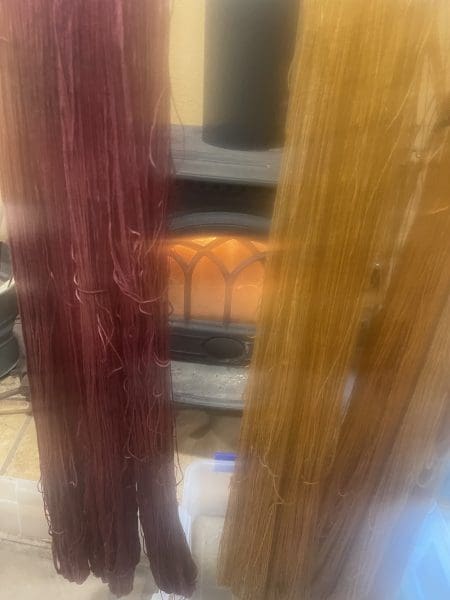Knitting Fiction
Chapter 08: Deborah, Dye Day

CHAPTER 8: Deborah, Dye Day
Deborah is sleeping. She lies on her back. Her mother, warm and solid, lies in the bed beside her, and facing her so that mother can watch over sleeping daughter. Deborah keeps herself quiet and does not open her eyes. She allows herself the pleasure of knowing she is being watched over by her mother. She is aware of the shifting bed and blankets as her mother, ever so quietly, rises to leave.
As Deborah begins to awaken, she raises her right hand and places it on the pressure dressings adhesed to the remains of her left breast. She comes to understand that she is not in bed, but instead in her recliner. She can still feel the presence of her mother who has just now left. Then she remembers that her mother’s ashes have been buried for 15 years. And yes, she knows that it is also true that her mother has just now left the room.
This is the second night in a row that Deborah is sleeping, sitting up, in her recliner. She awakens every two hours to pee, drink water, freshen her ice packs and reposition. During her last awakening she added a pain pill to her litany of nightly duties. The real thing. Not some over-the-counter anti-inflammatory. Because she wants to be able to move this morning. Yesterday, despite being only two days post-op, with drains, stitches, pressure bandages, and arm in a sling, she prepped everything she would need for today. A plastic tub is in the sink and filled with vinegar water. The 2-gallon kettle is on the stove and filled with water. Camel & silk yarn is stacked on the counter. It has been tied, and the skeins wound and tucked. The wood burning stove is prepped with fire starter and kindling. The blow torch her kids gave her for Christmas sits beside the firewood. It took her virtually all of yesterday to prepare for dye day. She kept her left arm tightly controlled in the sling for the entire project. The last thing she wants is to tear stitches or dislodge the drain. Using only her right arm, meant she had to make many, many trips back and forth from sink to kettle. Deborah predicted that yesterday’s increased activity would increase today’s pain and immobility. That’s why she took an opioid during the night. She notes her pain is indeed decreased this morning and it is easier to move. Drugs work.
Still within the aura of her mother, Deborah wonders if it was the opioid that brought her mother to watch over her while she slept. Or maybe her mother came of her own free will? Deborah has noticed that the older she gets, and the closer she gets to the end of her own life, the closer she gets to those who have already passed over. She favors the term “passed over.” It says out loud what she experiences inside. “Passed over to the other side,” is the full expression. Deborah is aware that, along with everyone else, she is inching her way across the region she thinks of as “this side.” She imagines there is some sort of barrier, or if not a barrier, at least a property line, between this side and the other. Sometimes she imagines it as a cliff that one must jump off of—similar to the leap of faith that Thelma and Louise made as they flew their Thunderbird into the Grand Canyon. Sometimes she imagines it as a sheer curtain that hangs between this side and the other—a curtain so very sheer, it does not shift with the blowing wind. One need not push it aside to pass through. Whether cliff or curtain, Deborah believes there is a boundary between this side and the other. As she moves toward the boundary, she draws closer to those who have already passed over. It’s only a breath’s width that separates her from those on the other side. Her mother easily wafted through the opium curtain to spend the night looking after her.
Deborah is smiling as she, inch by inch, pivots herself sideways in the chair, so that she can use her right arm to push up to a standing position. She’s smiling because she is enjoying that the words D-Y-E and D-I-E sound the same and are spelled differently. She has an itch. It just takes a moment to snag her phone and thumb in her question. Google tells her “homophone,”is the word she is looking for and her itch has been scratched.
She realizes that she is preparing to both dye and die. But now is dye time. First, she turns on the burner under her dye-kettle. Next she flips the switch on her prepped coffee maker, mixes her oatmeal and places it in the microwave to cook. Then she lights the wood burning stove. The house, that only a few minutes earlier was quiet and sleepy, is now wide awake and percolating. Coffee and oatmeal are steaming, wood burning stove is crackling, dye-kettle is heating.
She rehearses her process. First, she will remove or cover her kitchen, and remake it into a dye-station. She’ll turn on the exhaust fan above the stove, and open windows for cross ventilation. She’ll begin with the gold. She'll soak the yarn in mordant. Prep the kettle with Aztec Gold and just a tablespoon of vinegar. A gold that is deep and quiet. Confidant. Holding thee skeins together by their ends, she’ll very gradually dip them deeper into gold. Now with the gold in the water less intense, she’ll open the skeins and let them drift into the dye water, where they will remain until the water is clear. Next she will place the skeins in a flat pan with less than an inch of water, and using finger cots and a fine strainer, she will barely dust the gold with a touch of chestnut dye powder. Just as the water begins to sizzle, she’ll turn off the burners and place the lid, thus sealing and steaming the yarn for 30 minutes. Lastly, she will wash the yarn, and hang it in front of the wood burning stove to dry. Then she will repeat the entire process with red. Only this time she will use mostly Fire Red with a little Vermilion Red and enough Gunmetal Grey to achieve the color she wants— intense burgundy. She’ll dust with Gunmetal. The process would usually take about five hours. Deborah adds two hours to accommodate her slow, one armed, movements and rest breaks. She’s looking at six or seven hours to complete this project.
With the kettle heating and the fireplace crackling, she returns to her recliner to enjoy her morning coffee and oatmeal. Again, she rehearses her process. Not for dye day, she’s nailed that choreography. No, now she rehearses for die day. She wonders how this day could have slipped up on her so unawares. She knows herself to be a doomsayer. She is one who typically prepares for worst case scenarios. Indeed, she never tires of these preparations. She has a baseball bat leaning against her front door against intruders, an earthquake to-go bag waiting for the Big One, and a month’s worth of food and supplies—for end of days. Just in case. But she never saw this one coming. How could she have missed the essential point of doomsaying—which is preparing for actual death. She sips her coffee and ticks through her death’s " to do" list. Make a will. Give the kids access to financial information. Gather all the deeds, titles, and access to bank accounts into one place for them. Next, find a burial plot, and pay for it, along with cremation costs. Leave a letter taped to the fridge door with the particulars. And she needs to clean her house. She will erase her personal life. Those old photos she has kept of herself when she was 20 and naked? Those are history. Decades of schedule books and calendars, all gotta be hauled to the dump. She must sort through her pile of photo albums, toss the ones with scenery and no people. Write the names of people on the backs and sort them into separate albums, one for each of the kids. More cleaning. This is no time for nostalgia. Like Noah, Deborah does not need more than two of anything. After all, she might not live long enough to get to the third item. She will fill boxes of clothes and shoes and unfinished knitting projects for Salvation Army. Next week she will meet with the oncologist, and learn the results of the genetic testing of her tumor. She will learn the treatment. She will learn her odds. No matter the outcome, Deborah the Doomsayer is going to clean house. She is going to get ready to die.
But not today. Today is for dyeing not dying. Normally she would listen to her political podcasts, or an Audible detective fiction while she works. But not today. Today she wants inspiration. She wants something that will bolster her bravado. Tough. She wants tough. She spins her brain’s rolodex of movies and stops at “S” for “Strong Woman.” Ripley spins up. Physically competent, smart, tough and aggressive. Yes, Ripley is the answer. An itch. Thumbs pop around scratching until Google comes up with six movies in the Alien franchise. She’s pretty sure she only will need the first two, Alien and Aliens. There’s a sentence right near the end of Aliens that she very much needs to hear. Deborah awoke this morning with her mother watching over her. But now she wants more than being watched over. She wants, once again, to witness Ripley’s ferocious protection of the girl-child she is mothering.
Deborah moves her TV onto a prominent counter in her makeshift dye-shop. She knows she won’t watch every scene. She’ll have her eyes on her colors as much, or probably more, than on the TV. There will be times she will pay rapt attention to Ripley and other times to her yarn. There will be times she will pause the movie so that she can take breaks, ice her dressings, and eat meals. She’ll watch first Alien, then Aliens. She needs one particular sentence. By the end of the day she will hear that sentence. The scene she craves is near the end of Aliens. Ripley protects her girl-child, Newt, by cocooning herself into a hydraulic power loader. Ready to fight to the death, Ripley steps between the Queen of all Monsters and Newt. She throws the sentence like a hand grenade, the pin already pulled.
“Get away from her, you bitch!
.
